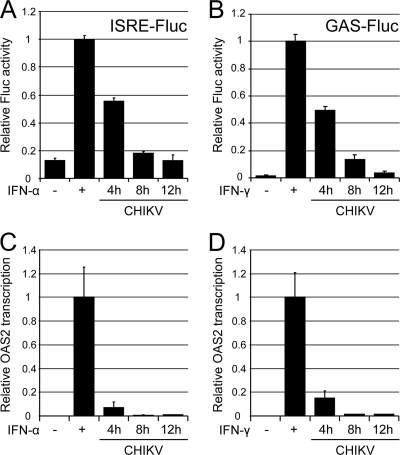FIG. 2.
Inhibition of type I/II IFN signaling and ISG induction by CHIKV infection. (A and B) Vero cells were transfected with a pRL-TK plasmid expressing Rluc and either a type I IFN-responsive (ISRE) or a type II IFN-responsive (GAS) Fluc reporter plasmid. At 24 h p.t., cells were infected with CHIKV at an MOI of 5 PFU/ml. At 4, 8, and 12 h p.i., cells were treated with IFN-α at 1,000 IU/ml (A) or with IFN-γ at 100 ng/ml (B) for 6 h; then they were assayed for Fluc and Rluc activities. Activities in mock-infected (uninfected) cells with/without IFN induction were also measured. Fluc values were divided by Rluc readings to compensate for virus-induced downregulation of transcription/translation and were expressed relative to values for mock-infected, IFN-treated samples. Average values from triplicate samples are shown. Error bars represent standard deviations. (C and D) Vero cells, either healthy or infected with CHIKV for 4, 8, or 12 h, were incubated with 1,000 IU of IFN-α (C) or 100 ng of IFN-γ (D) per ml for 10 h. Real-time RT-PCR values for the IFN-stimulated gene OAS2 were normalized to those for the housekeeping gene RPL13A. OAS2 mRNA transcription levels were expressed relative to those of mock-infected, IFN-treated samples. Average values from duplicate samples are shown. Error bars represent standard deviations.

